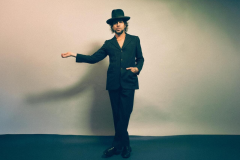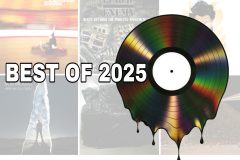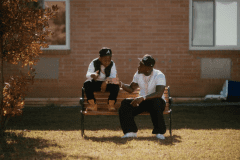From The Horse's Mouth: Ellis Ludwig-Leone (San Fermin) on San Fermin
San Fermin is a Brooklyn-based band led by 23-year-old composer Ellis Ludwig-Leone, who studied composition at Yale University and through his work as an assistant to Nico Muhly, has worked on arrangements for The National, Passion Pit, Sufjan Stevens, and more.
His band combines expansive, brass-infused pop with baroque string arrangements, and San Fermin features performances by a set of talented instrumentalists, including members of yMusic, ACME, Bon Iver, Asphalt Orchestra, and others. The result is a lush and sometimes brutal realization of the manic mindset of the newly adult, full of grandiose sentiment and eviscerating self-doubt.
Ghettoblaster caught up with Ludwig-Leone recently to discuss his self-titled, self-released album that drops February 12, 2013. This is what he said about it…
When did you begin writing the material for your most recent album?
I started writing in October 2011. It all came very quickly… I sketched out an outline for the whole record first; which kinds of songs would go where, what the interludes would sound like, some overarching themes, etc. I did that on the plane to Alberta. When I landed I tried to get through a song a day for the first few weeks. I would write the bulk of the material in the morning, take a walk, and then make cuts and solidify the structure in the afternoon. Evenings were for lyrics. The last few weeks I was just tweaking things, little lyrical changes and stuff like that. Oh, plus translating the MIDI into scores, that took some time. Then when I got back to New York I added two of the female-driven songs (“Sonsick” and “Crueler Kind”), because I realized that her character needed to be filled out a little bit to make the interaction with the male singer work.
What was the most difficult song to take from the initial writing stage through recording and mixing? Why was it so troublesome?
The first track on the record, “Renaissance!” was difficult because it was so dense. Initially it was even more dense, like, after he sings the first lyric I had this massive chorus of female vocals and strings and brass just barreling in. It was a cool effect but it kind of fucked up the form—where can you go if the first song on the record gives it all away? So that one was just a process of addition by subtraction, stripping things away and making those agonizing decisions, like, do you want that low brass choir or do you want the weird polyrhythms in the strings? Because keeping them both makes everything feel kind of flat. I would say it went through three rounds of thinning until we got it to its current, unwieldy but slightly more manageable, size.
Which of the songs on the record is most different from your original concept for the song?
There were a few false starts where the music wouldn’t really get to where I was hoping it would go- I threw those ones out. Like, there was this one instrumental passacaglia that was the very first thing I wrote, and actually generated a bunch of the harmonic themes for the album. Once I had written the rest of the record, that track seemed superfluous and repetitive, so I cut it. But it was super important for making the rest of the songs.
I guess the track that I kept on there that changed the most was “In Waiting.” I actually notated that first like a concert work. I think the first performance was at a classical workshop with a Canadian string quartet and two forty-something classical singers who I coerced into doing all this weird aleatoric stuff. Oh and then it ended with this big minimalist polyrhythm thing. I eventually cut a lot of that and used it for a clarinet quintet, hollowed everything out, and tried to make “In Waiting” feel like this sparse string purgatory.
Did you have any guest musicians play or sing on the record?
The whole thing was played by guest musicians, really. When I finished writing the majority of the record in December 2011, I had no idea who would play it. The only thing I knew for sure was that my friend Allen Tate would sing the male lead. The percussionist Nathan Petitpas was actually the first guy to record (I met him while in Canada), so for a while it was just his glocks and vibes and a bunch of MIDI. When I got back to New York it was a gradual process of finding players, friends and friends of friends. Obviously getting Holly and Jess (from Lucius) on board was a big step, because they have their own sound and strong ideas about what works for them, and they brought this petulance to the female character that really ended up defining her.
Who produced the record? What input did that person have that changed the face of the record?
I co-produced the record with Dan Molad at Sounds Like Fire Studios. I ended up being kind of tyrannical about it, which I’m sure was frustrating for Danny because he’s such a talented producer. But he’s definitely an Indie guy, and after a few mixing sessions I realized that some parts needed a natural, almost classical sound, so I was kind of a bulldog about keeping things clean.
Dan’s biggest contribution definitely came in the vocals and drums… I wanted a grittier, more effected sound for those things, and Danny was the one who really made those pop. And he was so good working with the Lucius girls in the studio, which makes sense since they’re in a band together and he and Jess are engaged and all. It was cute, sometimes he would get really absorbed in like a single snare edit while we were tracking and Jess would be like “Danny! You can do this later!”
Is there an overarching concept behind your new album that ties the record together?
There are a number of themes that persist throughout, and are often tied to some kind of musical motive. So like, there’s a chord progression associated with earnest male angst, and another one associated with the girl’s sort of forced nonchalance, that kind of thing. There’s probably five or six in all.
In general, though, I was trying to deal with the idea of, if you’re a twenty-something, relatively unreligious person, and you’re on your own for really the first time in your life, where do you look for meaning? And I followed that to the logical places… misplaced romantic love, nostalgia for simpler times, that kind of thing. The interludes helped to tie it together as these semi-liturgical breaths between the big moments. They were inspired by this scene in a book I was reading where a girl sits in a chapel and tries to pray but isn’t really sure what she’s praying for. I liked that idea, and I think those interludes add an element to her character that isn’t necessarily apparent in the songs.
Have you begun playing these songs live and which songs have elicited the strongest reaction from your fans?
Our first show is on December 19th at Pianos on the Lower East Side, which is totally terrifying for all kinds of reasons but mostly because having such a large group (11 musicians) makes it so hard to rehearse. Plus, since the arrangements are pretty complicated, some of the players require an actual musical score. So it will be an experiment. But we’ve started rehearsing and it sounds great so I’m excited.
The record comes out on February 12th, but we just released the first single, “Sonsick,” which has gotten a really positive response in these first few days. I liked the one review about it being “simultaneously anxious and celebratory.” It’s like a panic attack disguised as a birthday party.
(Check out this amazing song from the record: San Fermin – “Sonsick”.)








Social Media